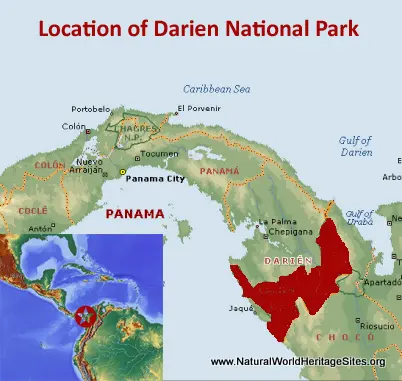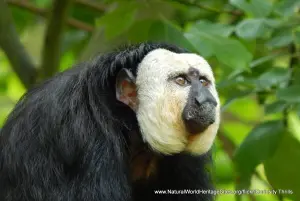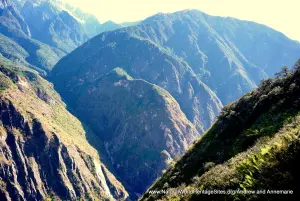EXPLORE the Darien National Park with this slideshow, check the location map and get all the facts and information below.
For slideshow description see right or scroll down (mobile). Click to view slideshow
Location and Values: Darien National Park straddles the land bridge that links North and South America, in the far south of Panama. It is an area of extraordinary biological diversity, inhabited by two Amerindian tribal communities. The land bridge between the two continents is geologically young, so the mix of species includes elements that have colonized the area from the previously-isolated continents of North and South America and have continued to adapt and evolve. The level of endemism is high across many taxonomic groups, while species richness is exceptional, with, for example, 533 species of birds and 169 mammals already recorded. The park covers an unusually wide range of elevation, from sea level to 1,875 m a.s.l., with a corresponding diversity of habitats including rocky coasts, sandy beaches, mangroves, palm swamps and a continuous transition of forest types from lowland rainforest to pre-montane, lower montane and montane forest, with cloud and elfin forest on the mountain summits. Darien National Park is contiguous with Los Katios National Park (720 km2) on the Columbian side of the international border, enhancing its value as a trans-national conservation area of unparalleled size and ecological complexity.
Conservation Status and Prospects. According to IUCN’s Conservation Outlook Assessment (2020) the conservation status of Darien National Park is of ‘significant concern’. The most immediate and pervasive threats arise from forest loss and the expansion of agriculture in the surrounding landscape, coupled with over-exploitation of natural resources within the park by indigenous people and other local communities. The rights and responsibilities of people living within the park are not clear, and the management response to illegal resource extraction and illicit trade has not been adequate. In the longer term, the prospect of a major international infrastructure corridor involving construction of the last remaining section of the Pan-America highway and power transmission corridor presents a major potential threat to the site.
Links:
Google Earth
Official UNESCO Site Details
IUCN Conservation Outlook
UNEP-WCMC Site Description
Birdlife IBA
Slideshow description
The slideshow ‘tells the story’ of Darien National Park with a portfolio of photos to illustrate the landscape features of the site, some of its typical plants and animals and the cultural characteristics of its indigenous people. The slideshow starts in the coastal areas before illustrating some of the typical wildlife of the lowland forest areas, including orange-chinned parakeet, white-faced capuchin monkey, red-tailed squirrel, tamandua, three-toed sloth, antbird and white-fronted hummingbird.
The next part of the slideshow features an Embera Indian community, illustrating their typical houses and lifestyles. The park boundary has some basic signage, but there is very little visitor infrastructure within the park. A couple of images illustrate one of the main rivers, flanked by dense forest, and distant views of steep-sided mountains. Some more of the typical species are shown, including a number of hummingbirds, agouti, capuchin monkey, tarantula spider, land iguana, crimson-crested woodpecker, agouti, Geoffroys tamarin, blue-headed parrot, caiman, various butterfies and a bright Urania leilus moth, crested eagle, collared aracari, blue cotinga, black-collared hawk, Amazon kingfisher and agami heron.
The following Flickr photographers and other sources are acknowledged with thanks for their contributions to this slideshow: Francesco-Veronesi, Gail-Hampshire, jacksnipe1990, Karsten-ten-Brink, Magnolia, steeleman204, Thierry-Leclerc, Vil-Sandi, Katerine-Rodriguez, Rich-Bojorquez-Davila and Rita-Willaert.
Factfile
Website Category:
Tropical & Sub-tropical Forests
Area: 5,790 km2
Inscribed: 1981
UNESCO Criteria:
- Outstanding natural beauty (vii);
- Ecological processes (ix);
- Natural habitat for biodiversity (x);
- Significant number of rare, endemic and/or endangered species (x)





